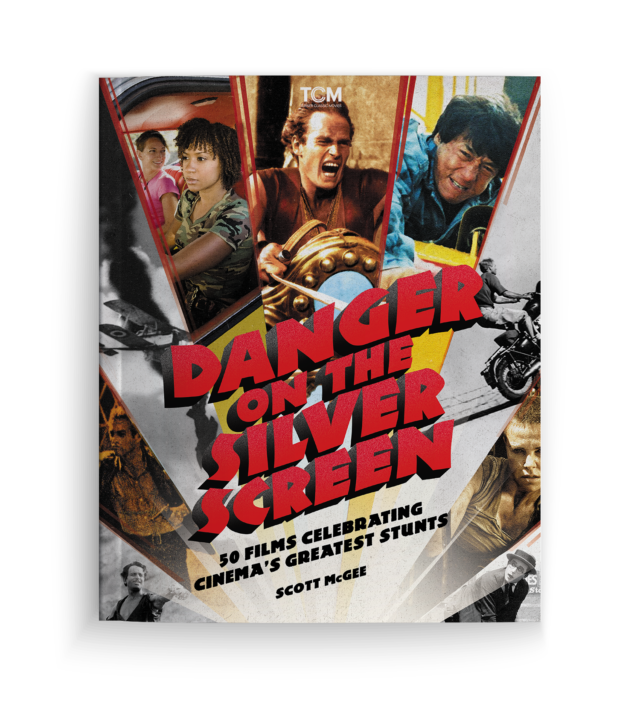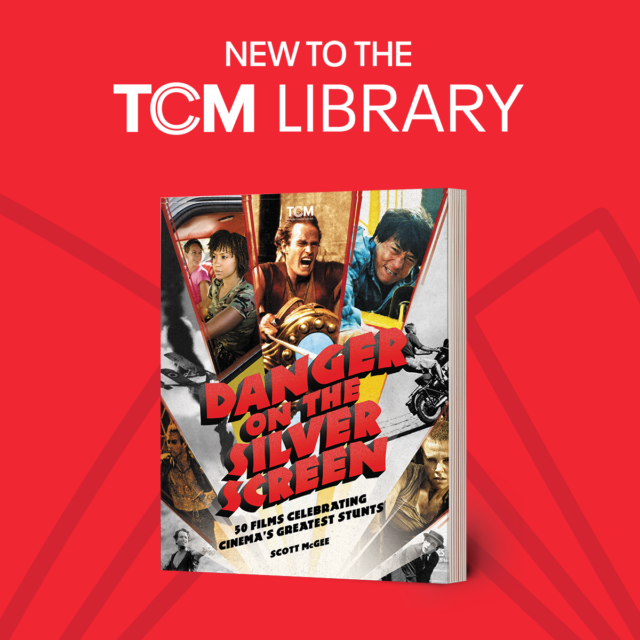“I might fall from a tall building
I might roll a brand new car
‘Cos I’m the unknown stuntman
That made Redford such a star. . .”
I bet right now you’re hearing Lee Majors’ voice in your head singing that anthem to stuntmen heard every week for years as the opening for the smash television hit, “The Fall Guy.” And who doesn’t love the derring-do of more than 100 years of stunts in movies and television? I do. You do. And most definitely TCM programmer and classic film aficionado turned author SCOTT McGEE does; in fact, Scott loves film stunts so much that it inspired him to write a book, DANGER ON THE SILVER SCREEN: 50 FILMS CELEBRATING CINEMA’S GREATEST STUNTS.

Chronicling a variety of some of the best stunts in the business over the years, in “Danger on the Silver Screen”, Scott takes us back to 1916 when stuntmen were first recognized thanks to a profile in the New York Tribune which noted, “the stunt men are the anonymous heroes who fall off the palisades, or skid into the river and keep on whistling.” Stuntwork is as integral to filmmaking as cinematography, costume design, scoring, and more.
Exploring how stuntwork has evolved, why it matters and how it services story, and who these people are who transfix us to the silver screen is passionately brought to life on the page by Scott. Chaptered primarily by single films that boast key stunts or key actors or stuntmen that have shaped the industry, Scott gives a chronological evolution of stunts in films, honing it down to 50 films, among them, “Safety Last!”, “The Black Pirate”, “How the West Was Won”, “Bullitt”, “Smokey and the Bandit”, “Romancing the Stone”, and “John Wick”. Bear in mind, these are not the 50 “best” stunt or action films and there are plenty more that could have been profiled in the book, but these 50 are key to history and the film industry as a whole.
I spoke with Scott at length about the book, his love of stunts, and where it all began. Needless to say, stunts were the stuff of dreams for a little boy.

“When I was a kid and saw ‘Raiders of the Lost Ark’ for the first time in 1981, it inspired in me a sense of I could do anything, a sense of invincibility and wanting to do things that only me as a 10-year-old could even dare to do, like climb up on top of my house, or jump off the garage, or swing across mines or climb trees, or jump bicycles off of ditches and, and just see how far I can how high climb, how far I can jump.”
But it’s not just little boys who dream. So do little girls and adults. “The reason why people like to watch stunts is that I think it inspires their imagination of watching people do things that they can’t normally do themselves. I believe stuntwork is very similar to dance, to musicals in the movies. People like to see human beings move in a way that they themselves can’t. When you see Fred Astaire and Ginger Rogers dancing, they can’t dance like that, but man, they really love watching Fred and Ginger dance. And similarly, when they watch a Douglas Fairbanks or a Tom Cruise film, they enjoy watching these guys do things that they would never be able to do. I think [stunts] gets to the very root of why people like to watch movies. And I think at the end of the day, they like to watch human beings in motion. And whether they’re crashing a car or hanging on the side of a building, it makes that romance that much stronger.”
With a passion and love for stunts himself, it was only natural that Scott would someday write a book on the subject, but even he didn’t know it would ultimately be a pandemic lockdown that would be the final catalyst when he put pen to paper 20 years after he first got the idea to do something about stuntmen.
As he relates, “When I first started at TCM in 2000, shortly after that in 2001, I had a chance to pitch a programming idea for the channel to my boss Charlie Tabish. ‘Why don’t we do something on stuntmen?’ Charlie loved the idea and to support it, a couple of producers were sent to Los Angeles for a three day film shoot to interview a lot of stuntmen and I tagged along as a researcher, almost like a production assistant. Spending those three days with people like Terry Leonard and Tony Brubaker, Bobby Joe Hooker, Jack Williams and a lot of other guys, many of many of whom have since passed away, it inspired in me a sense of there’s more story to tell here. I didn’t really have a clear idea of where I was going with this, but it was just something I really wanted to learn more about. . . I wanted to take that structure of looking at individual films and trying to tell a history of stuntwork in the movies through the lens of a handful of movies. I made my very first pitch ever to TCM because I thought if they turned me down, at least I’ll still have my day job. To my delight, they loved it.”

But tackling a subject as dense and vast as stuntwork in the movies covering more than 100 years, just how does one begin and then stay on point? While admitting that it was never easy, Scott successfully put together a comprehensive, cohesive, enlightening, and engaging book.
“I had a spreadsheet that I’ve been that I’ve had for many, many years, ever since I started to think about this as a book, of roughly 400 different films that I’ve looked at over the years, that I’ve taken notes on and along with the title, have the year of release, the studio, the director, the second unit or stunt coordinator, and some of the key stunt players involved. That was my blueprint for the films that I could talk about, which ones can best serve the story, and which ones can best help me tell this story as as complete as I can, within the confines of these 270 pages. I tried to look at films that people know but also try to look at the different dimensions; for example, stars doing their own stunts. Buster Keaton, Tom Cruise, Charlize Theron and others have done some of their own stunts. Then, the seismic films that really put some work on the map. I looked at films like “Stagecoach” or “Raiders of the Lost Ark”. I also looked at some of the niche stuff, the gags, aerial flights, car stuff, work with animals, work with falling gags. There were just so many different segments. But I also try to work in the key figures of stunts. Yakima Canutt to Carey Loftin to Jeannie Epper to Debbie Evans and more. And then address the films where stunt work has met the challenge of CGI and other technology head on and take a look at how stunt work has evolved and how it has changed along with the demands of the changing technology that the filmmakers use today.”
Scott also notes that there are “other dimensions of looking at stunts in television shows. Some of my earliest memories after becoming cognizant of life on Earth was seeing my dad watch ‘The Rockford Files’ in the 70s. James Garner was a guy that did a lot of his own stunts to the detriment of his own back. But there was so much fun work in ‘The Rockford Files’. Then you get into the ‘The Dukes of Hazzard’ and ‘The Fall Guy’ in the 80s. There were so many different things that I didn’t even talk about in the book. But I had to limit myself because you can’t cover everything. It was a struggle.”
An aspect of film and television production near and dear to my heart, reading “Danger on the Silver Screen” was like Christmas morning as page after page, Scott took me down memory lane with films and discussions of stuntmen who I knew and know, many of whom had regaled me years ago with their tales of some of the very stunts and action showcased in this book. And that’s where Scott truly excelled in putting together text and images to spotlight these amazing stunts and stuntmen.

“What I chose to include was how can I best tell this segment of the of the overall picture. When you look at the James Bond films, for example, I had to be very selective. With the very first Bond film that I talked about, ‘On Her Majesty’s Secret Service’, that might be a surprise to some readers that I didn’t make it all about ‘Goldfinger’ or ‘From Russia, With Love.’ I chose ‘Secret Service’ because of the nature of how the second unit shot those scenes, particularly involving skeet skiing and bobsledding and because of how those stunts were structured within the narrative of the film. I thought they took precedent over the more popular films like Sean Connery’s ‘Goldfinger’ or ‘Thunderball’. There are very few people that would say that George Lazenby was their favorite Bond, but in the context of stuntwork, I felt because of the magic of ‘Secret Service’ and that it ushered in the new era of how stunts were used within James Bond films and how they were incorporated, that’s the kind of things that we still see in James Bond films today.. . I had to be selective in terms of what am I really trying to say. Does it help me make the argument as to why this particular film was included over others.
At the end of the day, the book is about danger on the silver screen, not about actors on the silver screen. It’s about the stunt industry, the stuntmen and women, be it Bond or Burt Reynolds, although a couple of noticeable absences are films set in a galaxy far, far away, be they from “Flash Gordon” or “Star Wars” or the superhero MCU world.
Scott admits that in his research and the films he spent the most time looking at “were strictly on terra firma and set on Earth but not in the fantasy worlds of ‘The Lord of the Rings’. However, he quickly notes “That’s not to say that they shouldn’t be because there is incredible stunt work in those movies. What I perhaps subconsciously knew in my gut is that films that were based in the here and now are a familiar setting that people could relate to as human beings. I felt like the stuntwork is more palatable in terms of film. Those are actual human beings playing human characters in that movie and they’re doing these amazing things. When you’re watching a science fiction film set in a galaxy far, far away, the sense of wonderment isn’t necessarily about human beings doing incredible things, but about these incredible worlds being created.”
As comprehensive as DANGER ON THE SILVER SCREEN is, there are a few “big ticket” items that Scott does wish he could have included. Noting that they “would have been amazing to see”, at the top of Scott’s wish list are the films of Hollywood’s first western cowboy star, Tom Mix, who made just under 300 films along with his horse Tony who appeared in about 200 alongside him. All but nine of Mix’s films were silents. Unfortunately, very very few Tom Mix films still exist and those that do are difficult to gain access to or even screen because of their fragility.
Going beyond Tom Mix, also high on Scott’s wish list were films like “The Seven-Ups” from 1973 which he intentionally omitted. “The reason why I didn’t include it is because I have a lot of car chase movies in the 70s from ‘Bullitt’ to ‘Dirty Mary Crazy Larry’, ‘French Connection’, ‘Smokey and the Bandit’ and the like. So I had to drop some car chases. ‘The Seven-Ups’ is all about the one car chase through Upper Manhattan that Bill Hickman coordinated and drove, and what they do in that film is really kind of amazing. If I didn’t already have ‘Bullitt’ and ‘Vanishing Point’ and whatnot, I would have included ‘The Seven-Ups’.”
DANGER ON THE SILVER SCREEN. Human wonderment at its finest. “There’s never really been a book written like this about stuntwork in the sense of looking at it through 50 different films and telling the history through that lens…I’m pretty proud of being able to do that.”

About The Author
Scott McGee is the senior director of Original Productions at Turner Classic Movies. He is also a programmer for TCM’s annual TCM Classic Film Festival, the lead programmer for the TCM Classic Cruise, and has been a presenter at many of TCM’s past events and other industry conventions.
by debbie elias, exclusive interview 05/17/2022
*another version of this interview feature also appears in the Summer edition of “The Pen Name”











